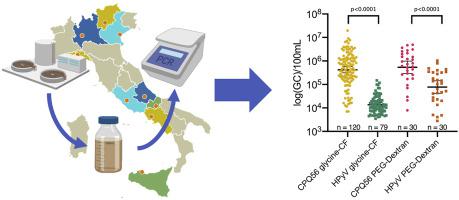Water Research ( IF 11.4 ) Pub Date : 2020-07-10 , DOI: 10.1016/j.watres.2020.116161 Katherine Crank 1 , Xiang Li 2 , Devin North 1 , Giusy Bonanno Ferraro 3 , Marcello Iaconelli 3 , Pamela Mancini 3 , Giuseppina La Rosa 3 , Kyle Bibby 1

|
Current fecal indicators for environmental health monitoring are primarily based on fecal indicator bacteria (FIB) which do not accurately represent viral pathogens. There is a need for highly abundant, human-associated viral fecal indicators to represent viral pathogens in sewage-contaminated water. In the present study, we evaluate the abundance of the emerging viral fecal indicator crAssphage in 156 Italian wastewater samples collected between 2014 and 2018. Samples were collected using two separate viral concentration methods, glycine-CF and PEG–dextran and qPCR assays were run for crAssphage (CPQ56) and Human Polyomavirus (HPyV) and endpoint PCR assays were run for Human Bocavirus (HBoc) and Hepatitis E Virus (HepE). CrAssphage was detected in 96% of samples and no statistically significant difference was observed in crAssphage abundance between concentration methods (p = 0.39). CrAssphage concentrations also did not correlate with location (latitude) or size (load and capacity) of the wastewater treatment plant. HPyV detection rates with the glycine-CF and PEG–dextran methods were 64% and 100%, respectively, and the concentrations of HPyV were statistically significantly influenced by the concentration method (p < 0.0001). CrAssphage was measured at significantly higher concentrations than HPyV for both concentration methods (p < 0.0001). The observed concentration ranges were 3.84–7.29 log10GC/100 mL for crAssphage and 3.45–5.17 log10GC/100 mL for HPyV. There was a strong positive correlation between crAssphage and HPyV abundance for both concentration methods; however, the slope of the correlation depended on the concentration method. CrAssphage presence correlated with the presence of HBoc in samples concentrated with glycine-CF, but did not correlate with the presence of HBoc concentrated with the PEG–dextran method or with the presence of HepE. Overall, these results demonstrate that crAssphage is an abundant viral fecal indicator in wastewater with statistically significant correlation with human viral pathogens (e.g., HPyV) and viral concentration methods influence the interpretation of fecal viral indicator detection.
中文翻译:

CrAssphage丰度及其与意大利废水中的分子病毒标记的相关性。
当前用于环境健康监测的粪便指标主要基于粪便指标细菌(FIB),这些细菌不能准确代表病毒病原体。需要高度丰富的,与人相关的病毒粪便指标,以代表被污水污染的水中的病毒病原体。在本研究中,我们评估了2014年至2018年间收集的156份意大利废水样本中新兴的病毒粪便指示物crAssphage的丰度。使用两种单独的病毒浓缩方法(甘氨酸-CF和PEG-葡聚糖)收集了样本,并进行了qPCR分析针对人博卡病毒(HBoc)和戊型肝炎病毒(HepE)进行了crAssphage(CPQ56)和Human Polyomavirus(HPyV)和终点PCR分析。在96%的样品中检测到CrAssphage,浓缩方法之间的crAssphage丰度没有统计学上的显着差异(p = 0.39)。CrAssphage的浓度也与废水处理厂的位置(纬度)或大小(负荷和容量)无关。甘氨酸-CF法和PEG-葡聚糖法检测HPyV的比率分别为64%和100%,并且浓度法对HPyV的浓度有统计学上的显着影响(p <0.0001)。在两种浓缩方法中,CrAssphage的浓度均显着高于HPyV(p <0.0001)。观察到的浓度范围为3.84–7.29 log CrAssphage的浓度也与废水处理厂的位置(纬度)或大小(负荷和容量)无关。用甘氨酸-CF和PEG-右旋糖酐法检测HPyV的比率分别为64%和100%,并且浓度法对HPyV的浓度有统计学上的显着影响(p <0.0001)。在两种浓缩方法中,CrAssphage的浓度均显着高于HPyV(p <0.0001)。观察到的浓度范围为3.84–7.29 log CrAssphage的浓度也与废水处理厂的位置(纬度)或大小(负荷和容量)无关。甘氨酸-CF法和PEG-葡聚糖法检测HPyV的比率分别为64%和100%,并且浓度法对HPyV的浓度有统计学上的显着影响(p <0.0001)。在两种浓缩方法中,CrAssphage的浓度均显着高于HPyV(p <0.0001)。观察到的浓度范围为3.84–7.29 log 在两种浓缩方法中,CrAssphage的浓度均显着高于HPyV(p <0.0001)。观察到的浓度范围为3.84–7.29 log 在两种浓缩方法中,CrAssphage的浓度均显着高于HPyV(p <0.0001)。观察到的浓度范围为3.84–7.29 log10 GC / 100 mL的crAssphage和3.45-5.17日志10 GC / 100 mL的HPyV。两种浓缩方法的crAssphage和HPyV丰度之间均存在很强的正相关。但是,相关的斜率取决于浓度方法。CrAssphage的存在与用甘氨酸-CF浓缩的样品中HBoc的存在有关,但与PEG-葡聚糖法浓缩的HBoc的存在或HepE的存在无关。总体而言,这些结果表明,crAssphage是废水中丰富的病毒粪便指标,与人类病毒病原体(例如HPyV)在统计学上具有显着相关性,并且病毒浓缩方法会影响粪便病毒指标检测的解释。











































 京公网安备 11010802027423号
京公网安备 11010802027423号